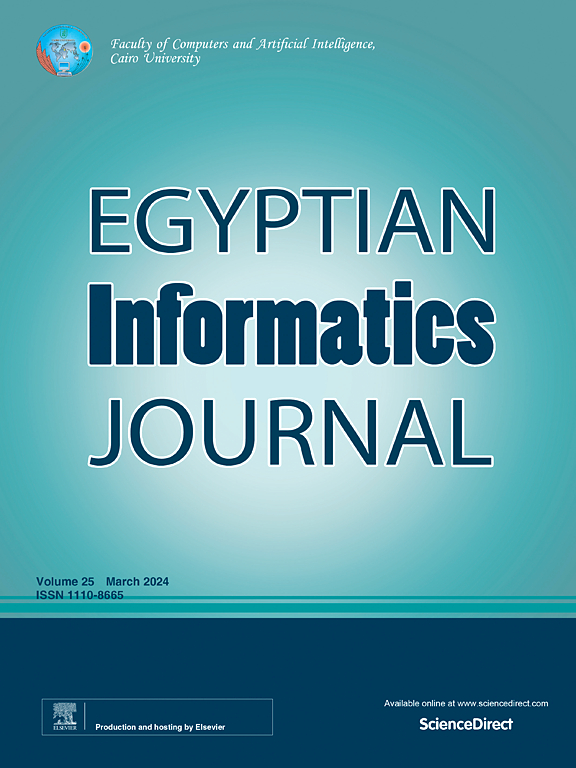利用动态学习预测不同级别脑癌的稳健优化的EfficientNet-B2
IF 5
3区 计算机科学
Q1 COMPUTER SCIENCE, ARTIFICIAL INTELLIGENCE
引用次数: 0
摘要
大脑是中枢神经系统的组成部分,由称为神经元的神经细胞组成。神经元在传递全身信号方面起着至关重要的作用。当大脑内的细胞发生异常和不受控制的生长时,就会导致脑肿瘤的形成。及时发现和治疗这些肿瘤对于防止包括死亡在内的严重后果至关重要。脑肿瘤的位置和大小会影响一个人面部和头部的对称性。准确诊断脑肿瘤需要医生的专业知识,他们可以使用磁共振成像(MRI)扫描对其进行手动评估和分类。这种精确的诊断对于制定有效的治疗方案和提高患者的生活质量至关重要。深度学习(DL)在脑癌的诊断和治疗方面有很大的潜力。利用DL技术分析MRI图像,对脑肿瘤进行分类,可以提高临床诊断的准确性,提高治疗效果。在本文中,我们提出了一种利用EfficientNet-B2的深度学习技术,该技术利用深度神经网络(DNN)的力量进行脑肿瘤检测。我们的模型结合了自适应学习率(ALR)技术,其中学习率(LR)在每一步开始时根据前一步的训练精度和损失值自动调整。此外,我们提出的模型利用梯度加权类激活映射(Grad-CAM)算法来识别与脑肿瘤相关的磨玻璃不透明(GGO)影响的特定区域。提出的DL模型有助于早期发现脑肿瘤,允许及时干预并改善患者预后,并且简化了诊断过程,从而减少了患者的时间和成本。我们使用两个公共数据集Br35H和脑肿瘤(BT)分别进行二分类和多分类任务的测试。使用调整大小和规范化技术对它们进行预处理,以确保输入的一致性。然后将我们提出的深度学习模型与传统分类器进行比较。对于多类分类任务,我们提出的模型的准确率、特异性、精密度、召回率和f1评分分别为99.81%、99.87%、99.62%、99.62%和99.62%。此外,该模型对二值分类任务的准确率达到了100%。对我们所提出的分类器的评估表明,基于EfficientNet-B2的DL模型,结合ADL率技术,在准确有效地诊断脑肿瘤方面显示出很大的潜力。它的高性能和减少诊断时间和成本的能力使其成为神经病学领域临床医生的宝贵工具。本文章由计算机程序翻译,如有差异,请以英文原文为准。
A robust tuned EfficientNet-B2 using dynamic learning for predicting different grades of brain cancer
The brain is the central nervous system component, consisting of nerve cells called neurons. Neurons play a vital role in transmitting signals throughout the body. When cells within the brain undergo abnormal and uncontrolled growth, it can lead to the formation of brain tumors. Prompt detection and treatment of these tumors are crucial to prevent serious consequences, including death. The location and size of a brain tumor can impact a person’s facial and head symmetry. Accurately diagnosing brain tumors requires the expertise of doctors who can manually assess and categorize them using magnetic resonance imaging (MRI) scans. This precise diagnosis is crucial for planning effective treatment options and enhancing the patient’s quality of life. Deep learning (DL) has the potential to greatly assist in the diagnosis and treatment of brain cancers. We can ensure more accurate clinical diagnoses and improve treatment outcomes by utilizing DL techniques to analyze MRI images and classify brain tumors. In this paper, we propose a DL technique utilizing the EfficientNet-B2, which leverages the power of deep neural networks (DNN) for brain tumor detection. Our model incorporates the adaptive learning rate (ALR) technique, where the learning rate (LR) adjusts automatically at the beginning of each step based on the training accuracy and loss value from the previous step. Moreover, our proposed model utilizes the gradient-weighted class activation mapping (Grad-CAM) algorithm to identify specific areas impacted by ground glass opacities (GGO) that are linked to brain tumors. The proposed DL model aids in the early detection of brain tumors, allowing for timely intervention and improved patient outcomes, and it streamlines the diagnostic process, resulting in reduced time and cost for patients. We conducted tests using two public datasets, Br35H and brain tumor (BT), for binary and multiclass classification tasks, respectively. They were preprocessed using resizing and normalization techniques to ensure consistent input. Our proposed DL model was then compared with traditional classifiers. For the multiclass classification task, our proposed model achieved accuracy, specificity, precision, recall, and F1-score of 99.81 %, 99.87 %, 99.62 %, 99.62 %, and 99.62 %, respectively. Additionally, the model achieved a perfect accuracy score of 100 % for the binary classification task. The assessment of our proposed classifier revealed that the proposed DL model based on EfficientNet-B2, incorporating the ADL rate technique, shows promising potential in accurately and efficiently diagnosing brain tumors. Its high performance and ability to reduce diagnosis time and cost make it a valuable instrument for clinicians in the realm of neurology.
求助全文
通过发布文献求助,成功后即可免费获取论文全文。
去求助
来源期刊

Egyptian Informatics Journal
Decision Sciences-Management Science and Operations Research
CiteScore
11.10
自引率
1.90%
发文量
59
审稿时长
110 days
期刊介绍:
The Egyptian Informatics Journal is published by the Faculty of Computers and Artificial Intelligence, Cairo University. This Journal provides a forum for the state-of-the-art research and development in the fields of computing, including computer sciences, information technologies, information systems, operations research and decision support. Innovative and not-previously-published work in subjects covered by the Journal is encouraged to be submitted, whether from academic, research or commercial sources.
 求助内容:
求助内容: 应助结果提醒方式:
应助结果提醒方式:


